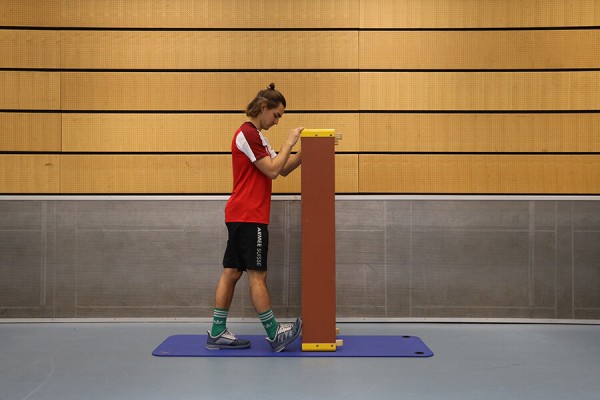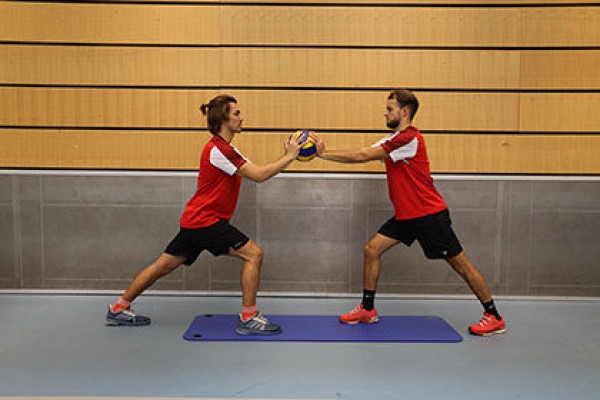Exercises (257)
Passive stretching: lower leg muscles (front) / thigh muscles (front) / neck muscles
Stretching
Individual work

With your knees shoulder-width apart, your shins and the top of your feet lie flat on the floor, lean your upper body back so that you can support yourself with your arms on your heels (same side of your body), look upwards, point your chest diagonally forwards and push your pelvis forwards.
No material required
Passive stretching: calf muscles
Stretching
Individual work

Light lunge, lean your body forwards and support yourself with your hands on the wall. Bend the front leg, stretch the back leg and place both feet flat on the floor (press the heel of the back foot against the floor). The stretch can be intensified by increasing the amount of support. Push your hips and front knee forwards while continuing to press your back heel firmly against the floor to support the dynamic stretch. Then switch legs.
Variant:
The exercise can also be performed without a wall by placing both feet flat on the floor in a stepping position and tilting the upper body slightly forwards.
1 wall/wall or similar
Passive stretching: calf muscles
Stretching
Individual work

Light lunge, with the front leg stretched and the back leg slightly bent. Bend the foot of the front leg (heel position) and pull the tip of the foot upwards (towards the body) with your hand. Then switch legs.
No material required
Passive stretching: calf muscles
Stretching
Individual work

Light lunge in front of a wall with straight legs, lift the toe of the front foot and press it against the wall while pressing the heel into the floor (the leg remains straight). The closer the heel is to the wall, the more intense the stretch. Then switch legs.
1 wall/wall or similar
Passive stretching: calf muscles
Stretching
Individual work

Stand with your feet hip-width apart, slightly forward and support your body against the wall with your hands. Keep your legs straight and your feet flat on the floor (heels pressed against the floor). The stretch can be intensified with a larger forward bend.
A wall or similar
Passive stretching: calf muscles
Stretching
Individual work




Light lunge, with the front leg stretched and the back leg slightly bent. Bend the foot of the front leg (remote position) and pull the tip of the foot towards the body with the aid. Then switch legs.
Per participant:
1 stick ►unihockey, intercrosse/lacrosse, Nordic walking
1 racket ►badminton/speedminton, smolball
1 throwing disc (frisbee) ►frisbee ultimate
1 elastic rubber band//string/skipping rope/playing rope
1 gymnastics stick with elastic band
Passive stretching: calf muscles
Stretching
Partner work

Lunge towards your partner. With your arms stretched out, press your palms against your partner's and press the heel of your back leg to the floor. Then switch legs.
No material required
Passive stretching: calf muscles
Stretching
Partner work

Stand hip-width apart opposite your partner, tilt your upper body forwards and press your palms against your partner's with your arms stretched out overhead (holding them up). Press your heels to the floor.
No material required
Passive stretching: calf muscles
Stretching
Individual work

In a stepping position, place both feet flat on the floor (front leg bent, back leg extended - press the heel of the back leg against the floor), lean the upper body forwards. The stretch can be intensified with a larger support. Then switch legs.
No material required
Passive stretching: calf muscles
Stretching
Individual work

From a shortened stride position, bend the back leg forwards at the knee joint so that the knee protrudes over the tip of the foot (the tilt creates a stretch in the lower calf of the back bent leg - heels always remain on the floor). Then switch sides.
No material required
Passive stretching: calf muscles
Stretching
Individual work

With the leg slightly bent, place the toe of the foot on a small elevation (e.g. step) and press the heel down. The supporting leg is either also placed on the elevation (better option) or underneath the elevation on the surface. Then switch sides.
No material required
Passive stretching: calf muscles
Stretching
Partner work





Stand hip-width apart opposite your partner, tilt your upper body forwards and press your palms against the aid with your arms stretched out overhead (holding them up) (clamp the object together). Press your heels onto the floor.
Per group of 2:
1 ball ►baseball, blitzball/rugby/football, fistball, futsal/football, handball, FooBaSKILL, volleyball
1 stick ► floorball, intercrosse/lacrosse, Nordic walking
1 racket ►badminton/speedminton, smolball
1 throwing disc (frisbee) ►frisbee ultimate
1 elasticated rubber band/power tube/skipping rope/playing rope
1 gymnastics stick with elastic band
Passive stretching: calf muscles
Stretching
Partner work





Lunge towards your partner. With outstretched arms, press the palms of your hands against the aid (pinch the object together) and press the heel of the back leg to the floor. Then switch legs.
Per group of 2:
1 ball ►baseball, blitzball/rugby/football, fistball, futsal/football, handball, FooBaSKILL, volleyball
1 stick ► floorball, intercrosse/lacrosse, Nordic walking
1 racket ►badminton/speedminton, smolball
1 throwing disc (frisbee) ►frisbee ultimate
1 elasticated rubber band/power tube/skipping rope/playing rope
1 gymnastics stick with elastic band
Progressive Muskelrelaxation
Relaxation
Individual work
Progressive muscle relaxation: Reducing muscle tension by systematically tensing and relaxing different muscle groups.
The participants spread out in the hall and lie on the floor (or on a small soft mat). At the instructor's command, they consciously tense a predetermined muscle group for 10-15 seconds and then release the tension again. After a 20-30 second break, the exercise is repeated 2-3 times for each muscle group.
Tighten and release the following muscle groups several times:
- Calf muscles left/right
- Thigh muscles left/right
- Buttock muscles
- Belly muscles
- Chest muscles
- Arm muscles (biceps) left/right
- Arm muscles (forearm) left/right
Note: This relaxation method requires good body awareness. Suggestions and templates can be found on the internet, among other places.
Per Tn:
1 soft mat (possibly)
Progressive muscle relaxation: relaxation for the whole body
Relaxation
Individual work
Progressive muscle relaxation: Reducing muscle tension by systematically tensing and relaxing different muscle groups.
How to do it: Lie on your back and just pay attention to your breathing for a few minutes (breathe in and out calmly 20 times). Then tense the whole body as tightly as possible (5 to 7 seconds). Feel the relaxation and muscle sensation for the next 20 seconds or so.
Per day:
1 soft mat (small)
Progressive muscle relaxation: relaxation of extremities and centre
Relaxation
Individual work
Progressive muscle relaxation: Reduce muscle tension by systematically tensing and relaxing different muscle groups.
Lay on your back and just pay attention to your breathing for a few minutes (breathe in and out calmly 20 times). Then tense individual body parts as tightly as possible (5 to 7 seconds). For the next 20 seconds or so, feel the relaxation and muscle sensation.
- Dominant hand and arm ("clench fist and press arm against support");
- Non-dominant hand and arm ("clench fist and press arm against support");
- Head and face ("grimace, squint eyes, wrinkle nose, press head against support");
- Upper body, stomach and buttocks ("consciously tense, clench buttocks tightly");
- Dominant foot and dominant leg ("clench feet slightly, lift whole leg off the floor at the same time");
- Non-dominant foot and leg ("clench feet slightly, lift whole leg off the floor at the same time").
Variant:
Power of imagination. The sequence is the same as the exercise above. However, you only imagine the tension (without performing it).
Per day:
1 soft mat (small)
Shadow boxing
Leakage
Individual work
Loose shadow boxing including sideways and upward hooks so that the shoulders are always in motion.
No material required
Shadow run
Leakage
Partner work
Groups of 2
The person in front moves freely forwards, backwards or sideways in the hall/area and incorporates various relaxation exercises (e.g. shaking out arms and legs). The partner imitates the movements identically. Swap roles from time to time or even switch partners.
No material required
Self-massage: chest muscles
Relaxation
Individual work
Starting position:
Position the ball next to the armpit and slightly under the collarbone with a block. Grasp the block with both hands by the sides or the notches.
Execution:
Apply pressure to the block (and therefore the ball) with your hand and work the entire pectoral muscle with circular movements. If a point in the chest muscles is particularly painful, the ball can be pressed into this point for several seconds to relieve tension. Then switch sides.
1 massage ball
Self-massage: sole of the foot
Relaxation
Individual work
Starting position:
Place one foot on the ball in a standing position.
Execution:
Place your body weight over the foot and move the ball back and forth on the sole of the foot using circular movements. If a point on the sole of the foot is particularly painful, the ball can be pressed into this point for several seconds to relieve tension. Then switch sides.
1 massage ball
Self-massage: gluteal muscles
Relaxation
Individual work
Starting position:
Sitting, place the ball under one side of the buttocks and support the hands next to the buttocks. Place the leg on the same side over the bent other leg.
Execution:
Move the ball back and forth under the buttocks by bending and stretching the bent leg (circular movements). The hands serve as a support. The pressure is relieved or intensified by slightly lifting the buttocks or pressing against the ball. If a point on the buttocks is felt to be particularly painful, the ball can be pressed into this point for several seconds to relieve tension. Then switch sides.
1 massage ball
Self-massage: Neck muscles
Relaxation
Individual work
Starting position:
Lying on your back, place the ball under your neck.
Execution:
Turn your head slowly to the left and right or make nodding movements. If one point of the neck muscles is particularly painful, the ball can be pressed into this point for several seconds to relieve tension
1 massage ball
Self-massage: upper arm muscles
Relaxation
Individual work
Starting position:
Position yourself sideways to the wall and wedge the ball between your upper arm and the wall (or on your side).
Execution:
Guide the ball along your upper arm by bending and stretching your legs. The intensity can be changed by applying more/less pressure with the upper body. If one point on the upper arm is particularly painful, the ball can be pressed on this point for several seconds to relieve tension. Then switch sides.
1 massage ball
Self-massage: Back muscles
Relaxation
Individual work
Starting position:
Standing, clamp the ball between your back and the wall (next to your spine).
Execution:
Roll the ball up and down your spine by bending and stretching your legs. The massage can be intensified by applying more pressure to the ball and reduced by reducing the pressure. Then perform the massage on the other side of the spine.
1 massage ball
Self-massage: Back muscles
Relaxation
Individual work
Starting position:
Sitting, place the ball in your lower back above the iliac crest and bend your legs slightly. Support your upper body with your arms as you lean backwards.
Execution:
Lean back slightly, lift the buttocks and slowly roll the ball forwards and backwards so that the entire lower back is covered (along the spine, not on the spine!). If one point of the back muscles is particularly painful, the ball can be pressed on this point for several seconds to relieve tension. Then switch sides.
1 massage ball